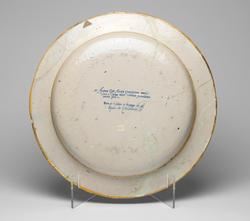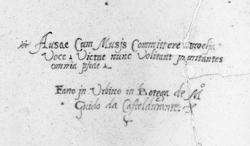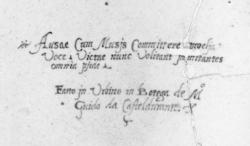Current Location: Gallery 7 (Courtauld)
Titles
The Contest between the Muses and the Pierides
Maker(s)
Workshop:
Durantino, Guido
Painter:
Gatti, Camillo
(Attributed)
Painter:
Rosso Fiorentino (Giovanni Battista di Jacopo)
(After)
Printmaker:
Caraglio, Giovanni Giacomo
(After)
Entities
Categories
Description
Maiolica dish, painted in polychrome, with The Contest between the Muses and the Pierides.
Pale buff earthenware, tin-glazed on both sides; the glaze on the reverse is pale beige and speckled. Painted in blue, green, yellow, orange, beige, brown, manganese, black, and a little white high-lighting. Shape 64. Circular with narrow rim, and wide, shallow well. The Contest between the Muses and the Pierides. The nine daughters of Pierus stand on the right separated by a stream from the Muses, led by Callipte who holds a harp. Above, a group of nymphs, gods and goddesses, including Apollo and Minerva, serve as judges. In the landscape background there are stunted trees on hills, and on the right, a coastline with buildings and distant mountains. The edge is yellow. The back is inscribed in the middle in blue, 'Ausae Cum Musjs Committere proelja/Voce Victae nunc Volitant jmmitantes/omnia pjcae/Fatto jn Urbino in Botega de Mo (o raised)/Guido da Casteldurante' (Having dared to have contests with the Muses and defeated by voice, they now fly away as magpies imitating everything). Single yellow bands encircle the junction of the rim and well, and the outer edge.
Notes
History note: Probably the Comtesse de Cambis; Baron Achille Seillière; sold Christie's, 13 July 1888, Catalogue of Old Italian Maiolica from the Collection of a Well-known Amateur, lot 198 (95 guineas); Sir Otto Beit, London; Sir Alfred Beit, BT, MP, London; sold Sotheby's, 16 September 1942, Catalogue of the Important Italian Majolica the property of Sir Alfred Beit, B.T., M.P., p. 23, lot 63; sold to Louis C.G. Clarke for the Fitzwilliam.
Legal notes
Purchased with the Glaisher Fund
Measurements and weight
Diameter: 46 cm
Height: 5.2 cm
Acquisition and important dates
Method of acquisition: Bought
(1942-10-16)
by
Sotheby's
Dating
16th Century, Mid
Renaissance
Circa
1545
CE
-
1550
CE
Note
Although the attribution to a workshop in Urbino is secure, the identity of the painter has been the subject of speculation. Orazio Fontana , Guido da Urbino's son, can be excluded because the painting on the front, and the handwriting on the back are far superior to those on a dish decorated with this subject which bore his monogram, which was formerly in the Schlossmuseum, Berlin but was destroyed during World War II. Bernard Rackham in 1940 considered that it might have been painted by Camillo Fontana, and in 1987 J.V.G. Mallet proposed Camillo Gatti as a likely executant. Another dish decorated with this subject in the same workshop was formerly in the collection at the Hôtel Lambert, Paris, sold at Sotheby's Paris on 11 October 2022. It is inscribed with the subject, the date, 1539, and 'In Botega de Mo Guido/de CaSteldurati' (In the workshop of Maestro Guido of Casteldurante). See Documentation.
The literary souce for the story of Muses and the Pierides was the Roman poet Ovid's Metamorphoses, Book V, 294-678. The nine daughters of Pierus, King of Emathia, overconfident of their musical talent, challenged the Muses to a singing contest. After all the contestants had performed, the adjudicating nymphs declared the Muses the winners. The Pierides unwisely clamoured against their decision, and as punishment for their presumption and rudeness were transformed into chattering magpies.
The source of the design was an engraving by G.G. Caraglio after 'The Contest between the Muses and the Pierides' by Rosso Fiorentino (1494-1540), probably the painting now in the Louvre in Paris (inv. 595: MR 69 dated to c. 1523-27. The inscription on the back of the dish was taken from the bottom of the print where it appears in capitals, AUSAE CUM MUSIS COMMITTERE PROELIA VOCE VICTAE NUNC VOLITANT IMMITANTES OMNIA PICAE. This was a popular subject on maiolica but few pieces decorated with the whole scene have survived.
School or Style
Renaissance
People, subjects and objects depicted
Materials used in production
metallic oxide colours
High-temperature colours
pale buff
Earthenware
Tin-glaze
Techniques used in production
Moulding
: Pale buff earthenware, tin-glazed on both sides; the glaze on the reverse is pale beige and speckled. Painted in blue, green, yellow, orange, beige, brown, manganese, black, and a little white high-lighting.
Painting
Tin-glazing
Inscription or legends present
- Text: Ausae Cum Musjs Committere proelja/Voce Victae nunc Volitant jmmitantes/omnia pjcae/Fatto jn Urbino in Botega de Mo (o raised)/Guido da Casteldurante'
- Location: Middle of back
- Method of creation: Painted in blue
- Type: Inscription
References and bibliographic entries
Related exhibitions
Identification numbers
Accession number: EC.35-1942
Primary reference Number: 47105
Stable URI
Audit data
Created: Saturday 6 August 2011
Updated: Tuesday 30 April 2024
Last processed: Wednesday 14 May 2025
Associated departments & institutions
Owner or interested party:
The Fitzwilliam Museum
Associated department:
Applied Arts

 IIIF Manifest
IIIF Manifest








